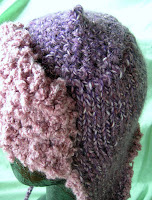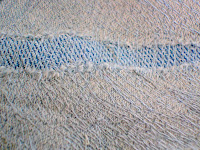I came across this hat when I was looking for a hat pattern for my sister-in-law the other day. It’s from Vouge Knitting so I can’t give you the pattern but it is available on their website. http://store.vogueknitting.com/p-260-russian-hat.aspx
Or it’s in the 2007 holiday issue. I thought it was quite cute so had to have a go at making it.
 The first problem, not of my own making, I encountered was the gauge. The pattern recommended needle size was 6.5mm (10 1/2), obtaining a gauge of 10sts and 16 rows over 10cm (4ins). Admittedly I didn’t have the yarn they prescribed but instead used 2 strands (as in pattern) of something called 'confetto', plus an extra strand of mohair. A single strand of this yarn had a recommended needle size of 7mm. I’m wondering if they gave the needle size for a single strand of yarn instead of a needle size for 2 strands because there’s no way I could get that gauge on that size needle. Anyway I used three strands from my stash and size 9mm needles.
The first problem, not of my own making, I encountered was the gauge. The pattern recommended needle size was 6.5mm (10 1/2), obtaining a gauge of 10sts and 16 rows over 10cm (4ins). Admittedly I didn’t have the yarn they prescribed but instead used 2 strands (as in pattern) of something called 'confetto', plus an extra strand of mohair. A single strand of this yarn had a recommended needle size of 7mm. I’m wondering if they gave the needle size for a single strand of yarn instead of a needle size for 2 strands because there’s no way I could get that gauge on that size needle. Anyway I used three strands from my stash and size 9mm needles.The pattern is knitted on a mixture of normal needles, a circular needle and double pointed needles. The double pointed needles were used at the very top of the crown when there were too few stiches for the circular. As I didn’t have any dpns of the right size I decided to crochet the very top. I removed one of the yarn strands (now only 2 strands-one being the mohair) and single crocheted each knit stitch from the needle and then decreased 8 stitches for each single crochet round. I removed one of the yarn strands because the crochet stitch is bulkier than the knitted stitches.
I also added a little tag at the top.
The third change was adding the ‘wool’. The pattern uses a yarn called ‘Curly’ with a loop simply pulled through each purl st bump.
Once again I didn’t have the appropriate yarn, but did have some boucle yarn. Working vertical rows I sc 1 into first purl st bump then dtr 1 into the next purl st bump, over the flaps and around the edges of the hat. I also added a couple of bobbles to the ends of the ties.




















 Figure 2
Figure 2 Figure 3. arrow shows chain stitch that the next stitch will be worked into.
Figure 3. arrow shows chain stitch that the next stitch will be worked into.


